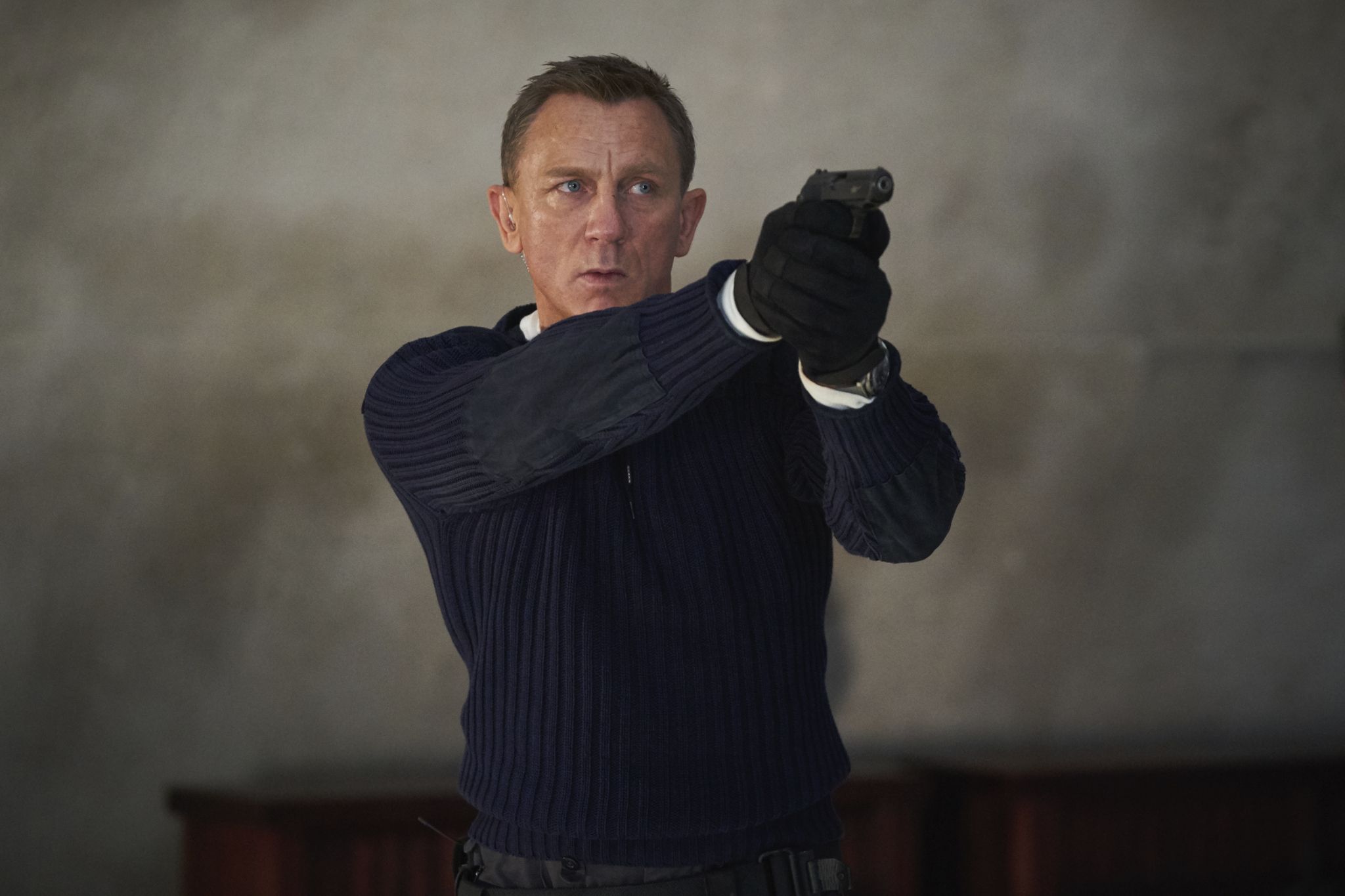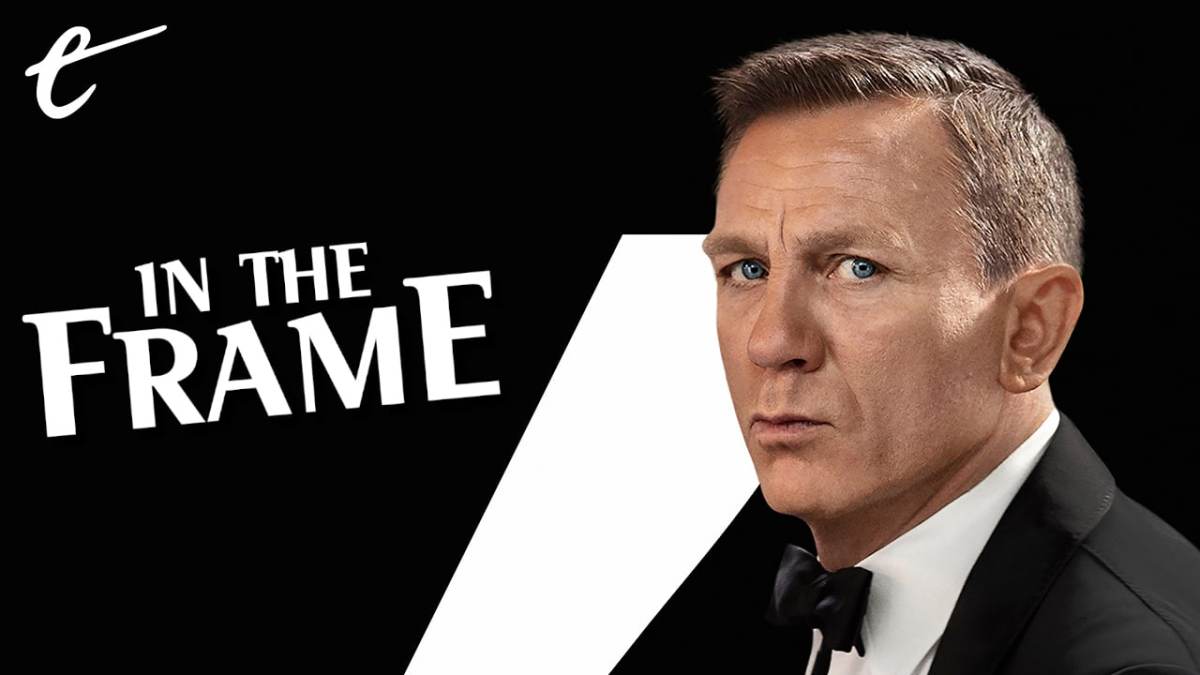This article contains mild spoilers for No Time to Die.
Performativity is part of what distinguishes the James Bond franchise from other espionage thrillers.
Ian Fleming originally wrote the character as something of a lifestyle guide. Fleming’s stories were obsessed with the preparation and consumption of food, giving over a not-insignificant amount of space to what the character ate and drank on his travels. Fleming’s books were saturated with brand names, all intended to serve as markers of distinction. James Bond was a man of wealth and taste, and Fleming cultivated that characterization by having Bond present himself to the world as such.
The character’s most iconic costume is a tuxedo, the kind of evening wear associated with the theater or a night entertaining. One of his most iconic catchphrases is the simple assertion of his own identity as “Bond, James Bond.” Multiple actors have come to be defined by it or to play off the role of Bond. Daniel Craig does product endorsements in character. Pierce Brosnan spent years playing off his time in the role in movies like The Tailor of Panama or The Matador.
The recent entries in the series — those starring Daniel Craig as the suave secret agent — aggressively foreground this performativity. Craig took over the role with Casino Royale, released four years after Brosnan’s last turn in Die Another Day. While Die Another Day was successful at the box office, it was a critical disappointment. After Brosnan revitalized the franchise with GoldenEye, Die Another Day risked turning it into a laughing stock.
More to the point, the Bond franchise had challengers. The same year that Die Another Day was released, The Bourne Identity radically reinvented action cinema for audiences by embracing a gritty and grounded style. However, this wasn’t the only potential rival. In the space between The World Is Not Enough and Die Another Day, John Woo’s Mission: Impossible II had grossed half a billion dollars by embracing a more contemporary action aesthetic.

There was a palpable anxiety around the casting of Daniel Craig, and not just because he was blonde. With Casino Royale, the franchise stripped itself back to basics. It dared to offer an origin story for the legendary superspy, telling the story of how this secret agent became James Bond. To this day, Casino Royale remains one of the great cinematic origin stories, up there with Christopher Nolan’s work on Batman Begins that same year.
While the earlier films understood that the character’s presentation and self-assuredness were a large part of the appeal, Casino Royale placed a much greater emphasis on the degree to which that persona was cultivated and rehearsed. Forced to infiltrate a high-stakes card game, Bond builds his familiar personality as a poker face. He walks into the Hotel Splendide in Montenegro and completely disregards his cover identity to announce himself as James Bond.
In Casino Royale, every familiar facet of the character’s personality is stage-managed. Vesper Lynd (Eva Green) orders a tailored tuxedo, instructing her colleague, “I need you looking like a man who belongs at that table.” For his part, Bond carefully choreographs Lynd’s arrival at the poker game in a revealing dress, because he needs her “looking fabulous” as a distraction for the other players. All of this is standard Bond movie stuff, but it is framed as a performance intended for an audience.
This element of performativity continues through Craig’s five films in the role. Quantum of Solace repeatedly parallels its action scenes to public spectacles, juxtaposing a horse race with an early chase sequence. The movie’s most memorable sequence is set at an opera, with the action on stage cut against Bond’s tuxedo-clad escape. It’s notable that Craig’s opponents tend to hide their faces. Raoul Silva (Javier Bardem) wears prosthetics. Lyutsifer Safin (Rami Malek) wears a mask.

These choices reflect the hero of the series. While Pierce Brosnan’s version of the character often seemed to thoroughly enjoy his work, Daniel Craig’s iteration was always consciously uncomfortable in the role in which he found himself cast — perhaps reflecting Craig’s own stated ambivalence about the part. Indeed, one of the central tensions of the five Bond films starring Daniel Craig is the question of who exactly controls the narrative.
This gets at the reimagining of the character Ernst Stavro Blofeld (Christoph Waltz) in both Spectre and No Time to Die. In Spectre, Blofeld takes Bond on a tour of his supervillain lair, which seems to consist largely of screens and monitors. Blofeld calls himself “a visionary,” but Bond insists that he is “not much more than a voyeur.” Blofeld insists that he is not just a watcher of Bond’s drama, but the director. “It was all me, James,” he boasts. “It’s always been me. The author of all your pain.” Perhaps “auteur” would be more appropriate.
In both Spectre and No Time to Die, Blofeld is the character who most aggressively tries to assert control of the narrative, and he does so through the act of looking. In Spectre, one of his first acts of onscreen sadism is an attempt to force Madeleine Swann (Léa Seydoux) to watch her father’s (Jesper Christensen) suicide. Spectre ends with Blofeld receiving a scar across his right eye, to mirror the design of Donald Pleasance’s iteration of the character in You Only Live Twice, but it is also symbolic.
Appropriately enough, No Time to Die returns to this theme of performativity. In many ways, given the film’s stormy and storied production, No Time to Die occasionally plays as an extended metaphor for how difficult it is to make a James Bond movie. The movie is saturated with screen and television imagery, particularly during the extended pre-credits teaser sequence where it seems that every groundskeeper and shepherd in Matera has a television set handy.

The opening sequence puts Bond through a carefully choreographed chase through the small village, designed to cycle through all the tropes. Blofeld rings Swann’s phone to taunt Bond, constructing a narrative of how Swann betrayed her lover. At one point, as Bond races through the streets, a farmer receives a phone call to release his sheep into the street to cause the sort of diversion that these sorts of sequences really need. The teaser finds Blofeld directing a James Bond action scene.
No Time to Die repeatedly draws attention to its artificiality. When Bond meets a young agent named Paloma (Ana de Armas), he has to feed her the proper cue for their greeting. As political appointee Logan Ash (Billy Magnussen) parts ways with Bond, he confesses that he is “a fan.” At the end of the pre-credits sequence, Bond is seen through the rectangular windows of a departing train car. It recalls frames of film, like those wrapped around Leo the Lion in the MGM logo.
As with Spectre, Blofeld tries to assert control of the narrative, even from prison. Henchman Primo (Dali Benssalah) has a cybernetic eye that is used to feed footage back to Blofeld so he can watch the “dailies” of this grand drama. At a covert and hedonistic party that looks like something from Eyes Wide Shut, stewards carry around an eyeball on a little cushion so that Blofeld can voyeuristically enjoy the festivities. (Eye imagery also looms large in the opera sequence in Quantum of Solace).
Much of the drama in No Time to Die derives from Blofeld losing control of the narrative that he is trying to construct around Bond. His place in the story is hijacked by Lyutsifer Safin. It’s an interesting (albeit likely unintentional) parallel with the film’s own troubled production, which famously saw director Danny Boyle departing the project to be replaced by Cary Joji Fukanaga. When Bond encounters Blofeld in No Time to Die, the “visionary” is safely locked in a box.

Daniel Craig reported that the production team was “constantly adjusting and readjusting the script” during shooting, and that is perhaps reflected in the way that so much of No Time to Die seems to be about several radically different James Bond movies happening around the title character as he tries to navigate them. Not unfairly, critic David Ehrlich described No Time to Die as “a melodrama that’s only masquerading as an action movie.”
In some ways, this is the central tension of Daniel Craig’s performance as James Bond in general and the character’s role in No Time to Die in particular. Craig’s iteration of the character has effectively abandoned his role three times over five films: in the last act of Casino Royale, at the start of Skyfall, and at the end of Spectre. Throughout No Time to Die, the secret agent seems to be trying to escape both the role of James Bond and the plot mechanics of a James Bond film.
Craig’s been candid that No Time to Die will see him taking his bow in the iconic role. So much of Craig’s tenure has been about the performance of Bond and the construction of narratives around that performance, so it is fitting that No Time to Die should return to that theme before the curtain call.






Published: Oct 1, 2021 11:00 am